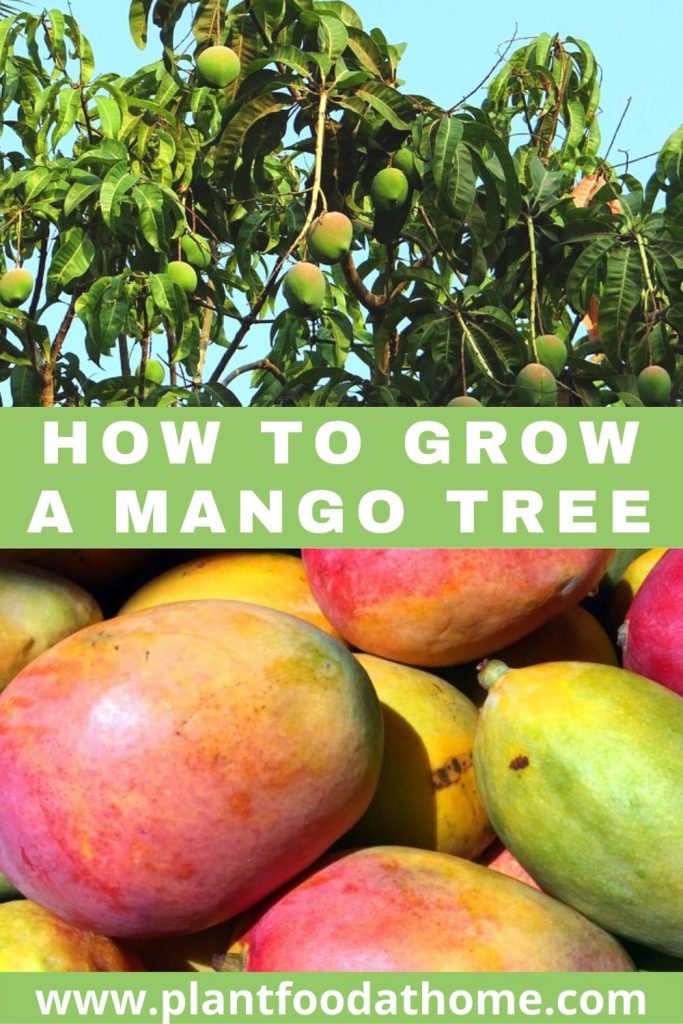Dream of growing your own mango tree and harvesting your own delicious fruits each summer? Then you’ve come to the right place. Find out how to grow a mango tree with step-by-step instructions for planting, caring for and harvesting mangoes.
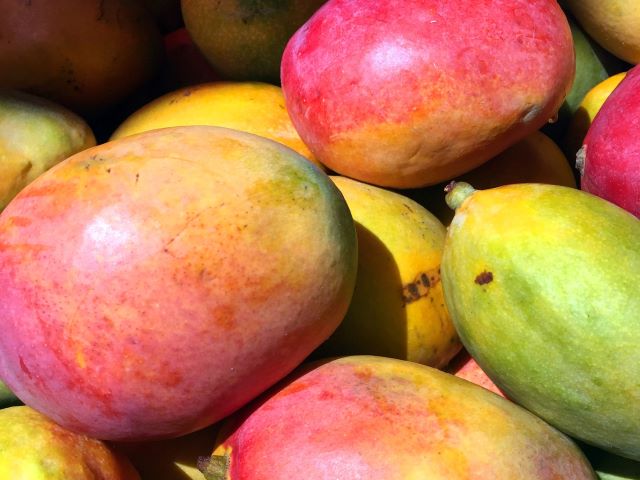
Table of Contents
- Mango Tree Plant Profile
- Ideal Growing Conditions for Mango Trees
- How to Plant a Mango Tree
- Mango Tree Pruning
- How Long Does It Take a Mango Tree to Produce Fruit?
- When to Harvest Mango Fruit
- How to Harvest Mangoes
- Storing Mango Fruit
- How to Eat Mango Fruit
- Recipes Using Mangoes
- Mango Varieties
- Common Pests and Disease
- Conclusion
- Some Favorite Gardening Products
Mango Tree Plant Profile
The mango tree, whose botanical name is Mangifera Indica, originates from South and Southeast Asia. Mango is a tropical tree that produces edible sweet fruit we all adore.
Depending on the cultivar, the fruit varies in shape, size, taste, and color. Commonly, we know mango fruit to be golden orange in color and about the size of an adult hand.
Mango trees can grow 32-130 feet (10-40 meters) tall depending on the variety, so they need plenty of room to grow in a garden space. Fortunately, mango trees can also be kept pruned to a manageable size of 10-23 feet (3-7 meters) for backyard growing. Or smaller dwarf and condo varieties can be grown.
The mango tree is a long-lived tree and can still bear fruit even after 100 years. Usually, the more mature the mango tree is, the better the fruit tastes!
Mango trees are self-pollinating, so you only need to plant one tree to produce fruit.
Ideal Growing Conditions for Mango Trees
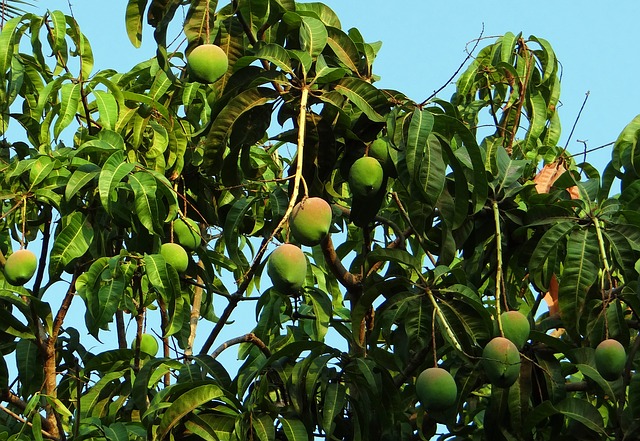
Mango is a tropical tree and primarily thrives in South and Southeast Asian countries like India, China, Thailand, Indonesia, and the Philippines. There are also varieties mainly produced by Mexico, Brazil, Peru, and Ecuador. While India is known as the number one producer of mango in the world.
In the United States, mango trees can be successfully grown outdoors in zones 9-11. And growing a smaller mango tree variety on a patio is a good option in zones 4-11 where they can be brought indoors during winter.
Climate for Mango Trees
The best growing temperature for mango trees averages from 80-100°F (26-38°C). So, it’s best to grow mango trees outdoors in a very warm climate.
Mango trees can’t survive freezing. They need to be kept as warm as possible with above 50°F (10°C). When the temperature is below 50°F (10°C), the flowers and fruit will fall off the tree.
Soil for Growing Mango Trees
Mango trees require a good amount of soil moisture to grow and produce well. The soil also needs to be well-draining. The best way to promote and encourage drainage would be to plant the mango tree on a slope or create a mound to plant into. However, be careful not to plant them on too steep areas as the drainage will be too much and the tree will not get enough water.
They prefer a soil pH ranging from neutral to slightly acidic 5.5 to 7.5 pH.
Watering Mango Trees
The amount of water the mango tree needs will depend on natural rainfall, temperature, and soil moisture retention. During dry weather, water regularly several times a week, making sure that the roots don’t sit in wet and soggy soil. When the mango tree is fully mature, they don’t need as much water and thrive well in periods of wet and dry seasons.
Sunlight for Mango Trees
Mature mango trees thrive in full fun. Aim to provide at least 8-10 hours of sunlight a day.
New or young mango tree seedlings may need some protection from the full sun while they are establishing.
Fertilizer for Mango Trees
Mango trees need nutrient-rich soil to encourage growth and promote fruit production, and fertilizers will help achieve this. To encourage flowering, slow-release fertilizer is ideal. This one here is a great option for an all-round organic fruit tree fertilizer, which is a 5-5-2. This fertilizer will help with consistent and healthy tree growth and fruit production. Other fertilizer mixes that are ideal for mango trees include 6-6-6 and 8-3-9-2, and the 2 indicates magnesium.
How to Plant a Mango Tree
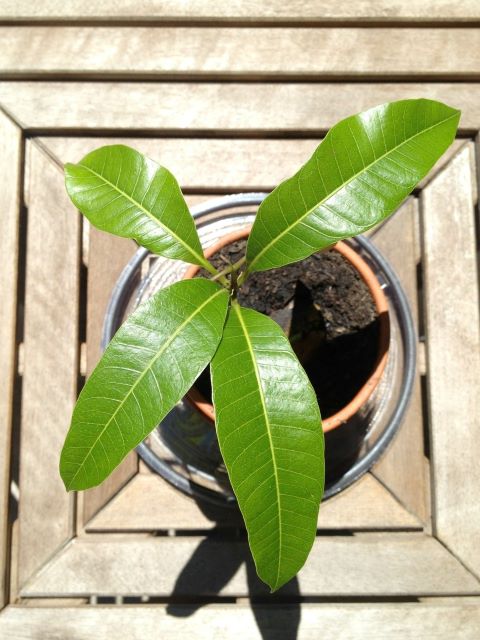
The easiest way to grow a mango tree is to plant a grafted variety purchased from a local garden center. Grafted mango trees produce reliable fruit and the time to fruiting will be much shorter than trying to grow a mango tree from seed.
However, growing a mango from seed can be exciting to experiment with, so if you would like to give it a go (along with an option for grafting for the advanced gardener), you can see our article here: How To Grow A Mango From Seed And By Grafting.
The best time of year to plant your mango tree is late spring or early summer when the soil is warm enough for the mango tree to help establish itself in the garden.
After you have selected the perfect mango tree for your garden, it’s time to find a sunny position where the soil is well-draining.
Dig a hole big enough for the size of the potted mango.
Place the mango tree in the hole and backfill with soil.
Water the mango tree in well and continue to keep up the watering every day or two while the tree is settling into its new garden position.
You can also add some organic mulch around the base of the tree, being careful to avoid the trunk. Mulch will help retain soil moisture and protect the young mango tree root.
If your mango tree looks a little fragile, it would be worthwhile providing stake support while it is still young.
Mango Tree Pruning
Pruning a mango tree is not difficult but does need to be done on a regular basis. Especially if you would like to keep your tree to a manageable size.
Young mango trees need pruning several times a year until they are around 5 years old. When new shoots reach around 20 inches, you can prune them off. This will encourage growth and shape to your young mango tree.
Over the next few seasons, this process may need to be done a few times throughout the year, depending on growth.
Once a mango tree is around 5 years old, an annual pruning after fruiting is all that’s required. This can also include removing a few thicker branches in the middle to encourage branching out rather than up.
How Long Does It Take a Mango Tree to Produce Fruit?
Grafted mango trees normally start to produce fruit in 3 to 5 years when grown in the right climate and conditions. While the trees grown from seeds usually take at least 5-8 years, if not longer, to start producing fruit.
When to Harvest Mango Fruit
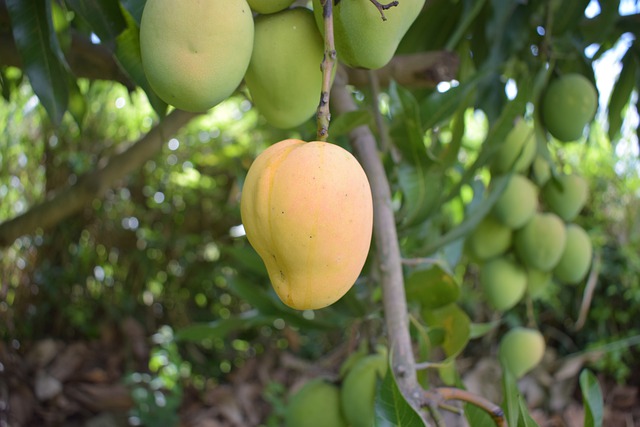
Mangoes start to change color to indicate they are ready for harvest. Depending on the variety, color may change from green to reddish-orange, orange, or yellow color depending on its variety. It can be a good idea to harvest mangoes before they are fully ripe as they will soften and potentially fall from the tree, causing damage to the fruit.
The development of ‘shoulders’ between the stem and top of the mango fruit is also another indication that it’s ready for harvest. The shoulder is an indented line beginning from the stem in the mango fruit which makes either side of the indent look like shoulders, as seen in the above photo.
From flowering to fruit harvest takes around 4-5 months.
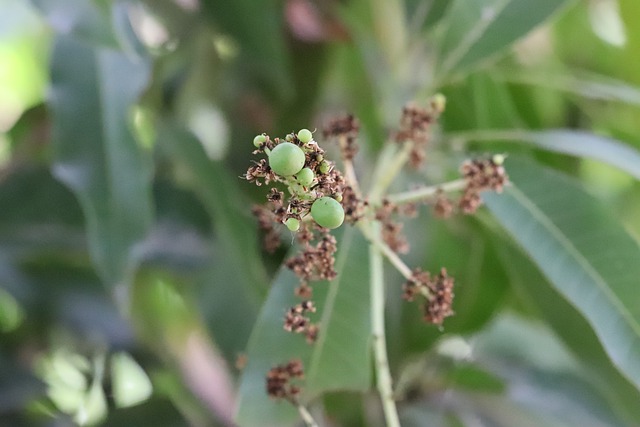
How to Harvest Mangoes
Mangoes can be hand-harvested by snapping off the fruit from the stem, or by clipping the stem 4 inches above the fruit. This will let the milky sap drain from the stem without touching the fruit’s surface, which will cause the mango fruit skin to discolor.
Some pickers use long poles with net or cloth bags at the end, like this one, to reach the fruit that is high above the tree. Given how big mango trees can get, a ladder is also useful for harvesting them.
Storing Mango Fruit
Storing mangoes the right way after harvest can extend their shelf life. Once harvested, mangoes can be placed in trays with the stem side facing down if possible. That way any sap will drain off, instead of staining the skin.
Mature but unripened mangoes can be stored as above and they will ripen over a period of 1-2 weeks.
Once mangoes are ripe, they can be kept in the refrigerator to slow down the ripening process. They are best eaten over the next 5 days or so.
Mangoes can also be peeled, cut, sliced, and placed in an airtight container in the refrigerator for several days or for several months when stored in the freezer.
How to Eat Mango Fruit
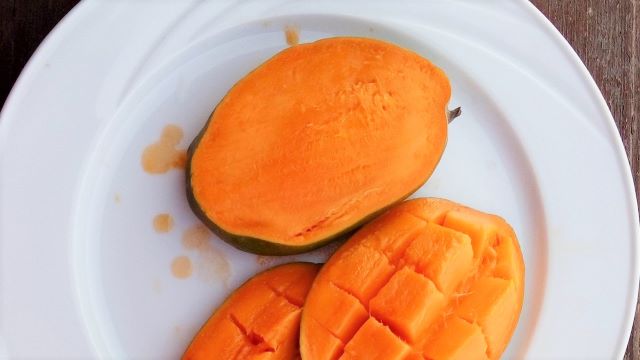
There are several ways to eat a mango, but I find the easiest way is to start by cutting the sides, or cheeks, off the mango on either side of the pit.
Do this by cutting one side vertically along the seed using a sharp knife. Try to get as close to the seed as possible. Then do it the same on the other side. Now you have two cheeks and one seed.
Peel the skin on the remaining seed and eat the flesh or using your knife, you can cut off the flesh around the seed.
The mango flesh on the two sides of the fruit, the cheeks, can be eaten using a spoon or by scooping out the flesh.
It’s also far simpler to get to the delicious mango fruit if you can carefully cut inside the cheek to create squares. Using your knife, slice the flesh just before cutting through the skin in horizontal lines and then across in vertical lines. The cheek can be then be turned inside out and the mango squares reveal themselves for eating. They can also be easily sliced off the skin and you will have cubes of mango.
Mangoes can also be peeled first before slicing them up but I find this more difficult as the mango flesh becomes slippery to handle.
Recipes Using Mangoes
Mango is one of the best ingredients for desserts, whether it’s a cake, smoothie, or in salads. Here are some of the recipes using mangoes.
- Mango Smoothie
- Mango Sticky Rice
- Fresh Mango Salsa
- Mango Cake
- Mango Mousse
- Easy Avocado & Mango Sushi Roll
Mango Varieties
For backyard growing, a dwarf mango tree would be ideal. Dwarf varieties will depend on local growers but lots of larger mango varieties can be grafted onto dwarf rootstock to produce a dwarf mango tree. Here are a few options for growing smaller vanities of mango trees.
Pickering – grows into a bushy tree and is known as a ‘condo mango’ due to its smaller manageable size. A delicious tasting tropical flavor with hints of coconut and low fiber texture.
Ice Cream – a good option for growing on a patio due to its smaller 6-foot mature size. The flavor, as the name suggests, is like eating mango ice cream or sorbet.
Cogshall – an excellent variety to grow in a container as it’s known to be a good consistent producer of delicious mangoes. Grows to 8 feet and is easy to manage in a pot.
There are also many other mango cultivars. Below is a small list:
Honey (Ataulfo) – a sweet taste with a smooth and creamy texture. While a smaller fruit size, it also has a smaller seed. The skin turns a deep yellow when fully ripe.
Francis – a fibrous flesh, with a sweet fruity taste, and turns golden yellow when it’s ripe.
Haden – this variety has an excellent sweet flavor. When ripe, the fruit turns a golden yellow with an attractive crimson blush to the skin .
Keitt – a fibreless fruit with a smooth sweet and fruity flavor. The Keitt is a Californian variety of mango.
Kent – sweet with a deep yellow flesh and little fiber texture. Favored for its late-season ripening.
Tommy Atkins – native to Florida and the most extensively grown variety in the United States. The flesh is firm and fibrous and has an attractive purple-red skin color.
Carabao (Manila) – this variety belongs to the Philippines and their national fruit. It has a sweet taste, juicy and soft with little to no fibers.
Alphonso – a fiber-free mango with a sugary sweet flavor.
Kesar – sweet with no fiber and a round shape.
Common Pests and Disease
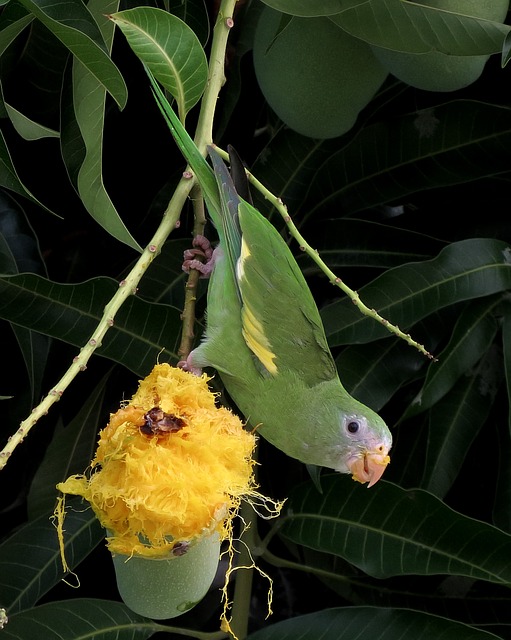
Mango trees are susceptible to pests and diseases, especially if they are grown in wet conditions. Fungus, bacteria, and insects feed on their leaves, stems, and fruits. Common diseases include Algal leaf spot, Anthracnose, Phoma blight, Pink disease, Sooty mold, and Bacterial black spot.
Common pests that attack mangoes are Fruit flies, Mango hoppers, Mango mealybugs, Mango tree borer, and White mango scale.
Control and management include pruning, applying fungicides and insecticides, cleaning the tree bases, and proper spacing of mango trees to promote air circulation among the trees.
Other pests can include birds, squirrels, and bats. Netting for these particular pests is a good option to prevent the loss of your mango harvest. Also, you can try harvesting the mango fruit while still green, but mature, and ripen them off the tree over the course of several days to a couple of weeks.
You may check this site for more detailed information on these pests and diseases and how to manage them.
Conclusion
Depending on where you are in the world, there are many varieties of mango trees you can choose to plant and add to your home garden. Not only will a mango tree grow into an attractive evergreen tree with shade but you will also grow amazing mango fruit to enjoy in the summer months!
Some Favorite Gardening Products
- AeroGarden Bounty Indoor Hydroponic Herb Garden
- King Bird Raised Garden Bed
- Felco Garden Pruners
- Sloggers Waterproof Garden Gum Boots
- Horticultural Neem Oil
Further Reading:
- Tree Tomato: How to Grow Tamarillo Trees and Eat The Fruit
- Tamarillo Tree Leaves Turning Yellow: Causes And Solutions
- How to Grow Avocados Indoors – And Will They Fruit?
- Why Is My Papaya Tree Dying? Causes and Solutions
- How To Grow Dragon Fruit: Planting, Caring And Harvesting
- 5 Reasons Dragon Fruit Plant Is Turning Yellow
